They say: "Hyper performance with extreme versatility."
We say: "Still favoring the former over the latter."
We love the idea of a street-legal supermotard, but the everyday reality, well, sucks. A converted motocross machine is mostly miserable in any street setting—uncomfortable, over-stressed at freeway speeds, and absolutely lacking versatility. Fun, sure, for a little late night jackassery, but almost useless as a day-in, day-out transportation device.
The 2013 Ducati Hypermotard 821 credibly captures the athletic character and hooligan attitude of a true supermotard without any of the conventional compromises. With its thin waist, gobs of ground clearance, and that high, wide handlebar, it feels just like a dirt bike (a dirt bike with a very comfortable saddle). And fitted with a torquey V-twin engine, sticky sportbike rubber, and dual front brakes, it offers more broadband performance than any typical supermotard, handling urban commuting, canyon carving, or even highway droning with ease.
The Hypermotard is a perfect compromise between sportbike and playbike, and it’s been successful for Ducati, selling more than 26,000 units since its 2007 debut. It’s proof of the validity of the Hypermotard concept that for this first update Ducati invested heavily in an all-new Testastretta 11 degree V-twin engine then added electronic rider aids including ride modes, traction control, and ABS to make the Hypermotard as sophisticated as any motorcycle on the market. The new bike maintains the anti-social identity of the original, but dials in more performance and safety to make it more attractive to an even wider range of riders.
Previously the Hypermotard was offered in two versions, with either an 1100cc or 796cc, air-cooled V-twin. Now there’s just one engine option, the new 821cc, liquid-cooled Testastretta V-twin, offered in three distinct models: the base Hypermotard, a high-performance SP version, and the forthcoming Hyperstrada fitted with saddlebags, a tall windscreen, and other commuter-oriented accessories. All three share a steel trellis frame with a light, stiff, diecast-aluminum subframe, as well as the same engine, though different ride-mode calibrations give each model different performance characteristics. We sampled the Hypermotard on the roads surrounding the mountain town of Ronda, Spain, and the SP at the nearby Ascari Race Resort; the Hyperstrada has yet to be launched.
Even though it gives up almost 300cc to the outgoing 1100cc Dual-Spark V-twin, the small Testastretta motor produces more power—a claimed 110 horsepower and 65.8 lb.-ft. of torque. Unlike the short-stroke 848 Testastretta that provides revvy, Superbike-like power delivery, the 821 engine uses the same 88mm bore as the 796, but with a longer, 67.5mm stroke to produce more low-end torque for improved rideability. It’s not a radically oversquare engine like the Panigale’s. The compact radiator is so efficient that no oil cooler is necessary, and the new engine has the longest service interval of any Ducati yet—clearances on the desmodromic valves don’t need to be checked until 18,000 miles, an interval equivalent to most Japanese machines.
The new motor is strong enough to satisfy the rowdiest lawbreaker, but it has newfound manners thanks to the long stroke, a heavier flywheel, and a system that injects air into the exhaust stream so that the fueling doesn’t have to be excessively lean at low rpm. These features combine to make this new engine calmer and smoother at low speeds than any Ducati V-twin before. Such refined engine characteristics, coupled with a wet, APTC slipper-gripper clutch that incorporates a self-servo mechanism to allow the use of lighter clutch springs, makes the new Hypermotard an unexpectedly gentle and user-friendly streetbike, too.
Although it seems superfluous on a bike called the Hypermotard, the addition of Ducati’s Safety Pack, consisting of three-level ABS and eight-level traction control (DTC), makes the bike even more friendly, helping moderate the Testastretta’s significant horsepower and especially the massive stopping power delivered by the trio of Brembo brakes. Ride-by-wire circuitry, with an electronic throttle grip signaling the Magneti Marelli engine management system, enables Sport, Touring, and Urban ride modes. Each mode prescribes different power characteristics, DTC interventions, and ABS thresholds. Sport and Touring deliver the full 110 bhp, the former with more immediate throttle response, reduced DTC intervention, and more lenient ABS thresholds. The Urban setting cuts peak output to 75 bhp with softer throttle response, maximum TC intervention and more conservative ABS thresholds. In addition to the three preset composites, TC and ABS response can be further fine-tuned independently, or the systems can be deactivated completely.
Ergonomics have been readjusted with the bars moved up slightly and the footpegs moved forward, enforcing an even more upright, dirt bike-like riding position. The super-tall, 34.2-inch seat is dirt bike-like as well (a ¾-in.-lower accessory seat is available), and a deep-scooped bucket makes it hard to move back and forth. The handling characteristics invite even more dirt bike comparisons. The motocross-type handlebar and tall center of gravity make the Hypermotard immediately responsive to even light steering inputs, which takes some getting used to. Handling is lively but stops just short of becoming nervous, thanks to slightly more relaxed steering geometry and a slightly longer wheelbase this year.
Even at semi-legal speeds you can feel distinct differences among the three preset ride modes. For garden-variety street riding we preferred the Touring setting; the combination of very light throttle action and very responsive fueling made thrust difficult to modulate smoothly in Sport mode, especially over rough pavement. That’s not to blame the long-travel suspension, with 5.9 in. from the Sachs shock and 6.7 in. from the Kayaba fork. Both ends are sprung firmly enough to maintain composure even under aggressive riding, but still deliver excellent comfort at any speed.
Transferring from mountain roads to the awesome Ascari Race Resort gave the opportunity to appreciate the extra performance of the SP model, which adds a fully adjustable Öhlins shock and Marzocchi fork, the same super-light, forged-alloy Marchesini wheels found on the Panigale S (wrapped with super-sticky Pirelli Supercorsa SP tires), some carbon fiber trim pieces, and magnesium engine covers. The SP weighs 8.8 pounds less than the base model, which, at a claimed 386 lbs. dry, is less than 7 lbs. heavier than the old bike—even after the addition of liquid-cooling, traction control, and ABS.
The SP also benefits from more aggressive Race/Sport/Wet ride-mode settings, which deliver even more dynamic throttle response, more permissive traction control, and, in Race mode, front-only ABS intervention that allows unlimited rear-wheel lift for backing the bike into corners—behavior the Hypermotard is all too willing to oblige. The ABS activation threshold is acceptably high in Race mode, and the Bosch 9MP control box trims braking inputs without any feedback at the lever. The track sessions also gave an opportunity to experience the latest DTC iteration, which, Ducati says, now limits wheelspin solely by retarding ignition—not fuel—for even smoother engagement. In the lowest two settings TC, intervention is absolutely transparent except for activating the dash indicator—which confusingly doubles as the shift light.
Ducati calls the Hypermotard “the ultimate combination of racing DNA and urban ability.” Riding this new version, which is both faster and more friendly than before, has us agreeing with this characterization. The Hypermotard is still edgier and more aggressive than the stalwart Monster model, but it’s now more broadband-capable. And it’s still light-years ahead of any “true” supermoto, making it perfect for pragmatic hooligans.
EVOLUTION
The Hypermotard gets an all-new, liquid-cooled Testastretta V-twin engine and Ducati Safety Pack electronics, including ABS and traction control.
RIVALS
Aprilia Dorsoduro 750/1200, Ducati 848 Streetfighter, Triumph Street Triple
VERDICT 4 out of 5 stars
Mission accomplished: Ducati makes the Hypermotard more accessible without dumbing it down.











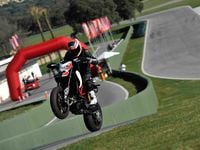
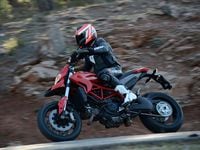
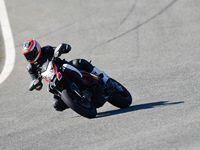
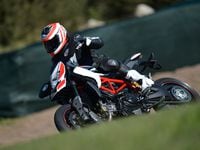
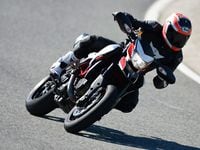

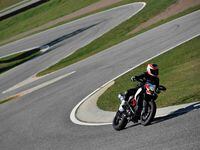

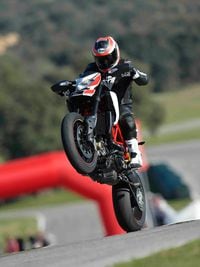
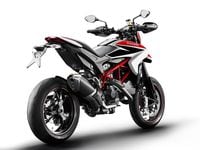
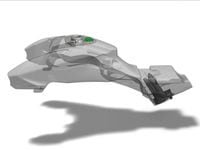
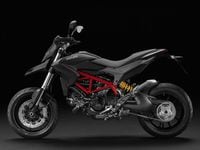
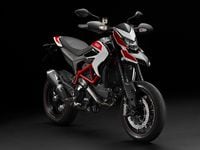

/cloudfront-us-east-1.images.arcpublishing.com/octane/VZZXJQ6U3FESFPZCBVXKFSUG4A.jpg)
/cloudfront-us-east-1.images.arcpublishing.com/octane/QCZEPHQAMRHZPLHTDJBIJVWL3M.jpg)
/cloudfront-us-east-1.images.arcpublishing.com/octane/HXOUJXQWA5HBHGRO3EMJIGFMVI.jpg)

/cloudfront-us-east-1.images.arcpublishing.com/octane/3TIWWRV4JBBOLDVGRYECVVTA7Y.jpg)
/cloudfront-us-east-1.images.arcpublishing.com/octane/KIX5O23D5NAIBGFXBN3327DKZU.jpg)
/cloudfront-us-east-1.images.arcpublishing.com/octane/7GJYDUIPXRGMTMQKN6ONYOLBOU.jpg)
/cloudfront-us-east-1.images.arcpublishing.com/octane/MUQLOVLL2ZDGFH25ILABNBXKTI.jpg)
/cloudfront-us-east-1.images.arcpublishing.com/octane/TNOU5DNE2BC57MFPMGN2EIDXAM.jpg)
/cloudfront-us-east-1.images.arcpublishing.com/octane/GTCXACQGJ5HAPDTGWUQKDEH44E.jpg)
/cloudfront-us-east-1.images.arcpublishing.com/octane/S35YGSEMEZB4BLTDJTSZPF4GLA.jpg)
/cloudfront-us-east-1.images.arcpublishing.com/octane/5UOT6HPX2JFMRJAX6EH45AR4MQ.jpg)
/cloudfront-us-east-1.images.arcpublishing.com/octane/OKWOJWAKP5EP3OACCRRWPCIX2Q.jpg)
/cloudfront-us-east-1.images.arcpublishing.com/octane/2WF3SCE3NFBQXLDNJM7KMXA45E.jpg)
/cloudfront-us-east-1.images.arcpublishing.com/octane/G4MG6OUCJNBSHIS2MVVOTPX65E.jpg)
/cloudfront-us-east-1.images.arcpublishing.com/octane/IIGGWFOTOJGB7DB6DGBXCCMTDY.jpg)
/cloudfront-us-east-1.images.arcpublishing.com/octane/QSTCM6AVEZA5JJBUXNIQ3DSOF4.jpg)
/cloudfront-us-east-1.images.arcpublishing.com/octane/U4I7G625B5DMLF2DVIJDFZVV6M.jpg)
/cloudfront-us-east-1.images.arcpublishing.com/octane/B6XD6LS6IVCQPIU6HXDJSM3FHY.jpg)
/cloudfront-us-east-1.images.arcpublishing.com/octane/ICL63FEDDRDTTMINYICCEYGMDA.jpg)
/cloudfront-us-east-1.images.arcpublishing.com/octane/FCGZHQXRBZFLBAPC5SDIQLVF4I.jpg)
/cloudfront-us-east-1.images.arcpublishing.com/octane/WNOB6LDOIFFHJKPSVIWDYUGOPM.jpg)

/cloudfront-us-east-1.images.arcpublishing.com/octane/X33NU3E525ECRHXLNUJN2FTRKI.jpg)